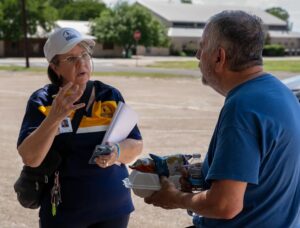
GAINESVILLE, Ga. (BP)–The man who apparently set more churches on fire than any other individual during the last decade will spend the rest of his life in prison. And while many of the 829 churches targeted for arson between 1995 and 1999 were presumed to have been an expression of racial hatred, arsonist Jay Scott Ballinger says he drew his inspiration from Lucifer.
The rural Indiana man was given a life sentence Aug. 17 in U.S. District Court in Gainesville, Ga., after pleading guilty last April to setting five rural churches on fire in northern Georgia in 1998 and 1999. Earlier, Ballinger received a 42-year prison sentence for the fires he started in seven other states.
In many cases, nearby communities rallied to rebuild the churches, and sometimes attendance increased following the damage. The impact was far different in north Georgia, however, when Ballinger’s crime led to the death of a volunteer fireman who suffered a fatal heart attack after helping fight the blaze.
Ballinger’s eight-state crime spree ended in early 1999 when he suffered burns to his own body after setting a fire in Ohio. After several days of enduring the pain back home in Indiana, his parents called for medical assistance, drawing the suspicions of local police.
When the Federal Bureau of Investigation searched his Daleville, Ind., residence, they found evidence of satanic paraphernalia, including pentagrams, goat heads and a book of spells. According to local news coverage, a Daleville police officer had reported in 1993 that Ballinger had solicited teenagers to sign blood contracts with the devil. Some of them described being intimidated by the 31-year-old who called himself a worshiper of Lucifer.
One of his accomplices admitted that he vandalized several church buildings with satanic symbols while Ballinger set them on fire. The other participant, an exotic dancer from Georgia, also testified against Ballinger in a plea-bargaining agreement that landed her in prison.
“To everyone who was harmed and left with crazy memories caused by my barbaric actions, I want you to know I’m sorry and have learned my lesson,” Ballinger related in a note read by his attorney prior to the sentencing. He expressed regret for the pain and loss of the firefighter’s family, and for having caused his own family and friends to suffer.
Gentry Shelnutt of the U.S. District Attorney’s office in Atlanta said there was no evidence that Ballinger targeted churches of a particular denominational affiliation. “It just had to do with whether or not it was something easy to do,” Shelnutt said, describing all three of the north Georgia churches that were burned as being situated in very rural areas of the mountainous region. “There was not even a house within view.” As a result, he said the destruction was greater since the fires did not attract attention.
Public affairs officer Patrick Crosby of the Department of Justice explained that Ballinger’s willingness to enter a plea bargaining agreement kept the background information of the case from appearing on the public record. As a result, detailed explanation as to Ballinger’s motive is not available.
However, Assistant U.S. Attorney Susan Dowd of Indianapolis told Baptist Press, “This was definitely not racism.” While Ballinger claimed he was responsible for as many as 50 church fires in 11 states, Dowd said indictments were issued only when evidence could be established. Aldon Taylor, public information officer for the state fire marshal, said Ballinger is believed to have caused another 20 fires, though evidence was inconclusive.
Court documents indicate that Ballinger traveled around the country practicing his religious beliefs as a Luciferian. His writings expressed hostility toward Christianity and referenced study of Satanism, the occult, witchcraft and non-Christian beliefs.
Daleville Police Chief Mike Myers said Ballinger’s involvement in satanic activity was “an isolated incident.” While a “spiritualist camp” developed in nearby Chesterfield, Ind., Myers said Ballinger was the only individual locally involved in what was described as “worship of Lucifer.”
A former pastor of the SBC-affiliated Calvary Baptist Church in Seymour, Ind., recalled a fire that damaged a building under construction in 1998. Although no evidence could be found to tie the blaze to Ballinger, suspicions arose a year later when the Indiana native was accused of having started 14 church fires across the state.
Crosby of the Department of Justice said the government concluded that Ballinger’s actions were randomly conducted. “He was on the road with his girlfriend and it was not like there was heavy research or targeting. He was looking for opportunity, rather than a motive of not liking a particular church. To say he targeted a church is inaccurate. He was just looking for any church. That seemed to be his criteria more than anything else.”
Prosecutors reported that Ballinger typically broke a church window, poured gasoline inside, then ignited the fire with a cigarette lighter. Among the casualties was the century-old white frame church featured in the opening scene of the 1985 movie Hoosiers that graced Lebanon, Ind.
A three-year investigation by the National Church Arson Task Force involved the study of more than 800 arsons, bombings or attempted bombings occurring between January 1995 and October 1999. In a report issued last year, the committee indicated that law enforcement agencies made 364 arrests and obtained 267 convictions. “The Ballinger indictments represent the largest number of fires linked to a single defendant during the life of the Task Force,” the final report stated.
Southern Baptists were among numerous religious groups that condemned church arson in 1996. The convention raised more than a quarter million dollars for rebuilding efforts and recruited volunteer teams to assist in the effort.
“The federal government doesn’t know everything and see everything, but there remains a possibility that there are other church fires he could be linked to.” Still believing that Ballinger showed no racial motivation for his crimes, Crosby said, “His involvement in rural church fires in the South certainly goes back to the era” when widespread destruction of black churches was rampant.
After Ballinger was indicted in Indiana, charges filed in other states were transferred there, tying him to a total of 26 fires. U.S. attorneys in the states of Alabama, California, Kentucky, Missouri, Ohio, South Carolina and Tennessee agreed to the plea agreement reached by attorneys in Indiana. However, Georgia attorneys opted to file separate charges in five additional church fires, including one that led to the death of the 27-year-old volunteer firefighter.
The 42 l/2-year prison sentence Ballinger received in Indiana included a judge’s order to pay $3.6 million in restitution. The Georgia verdict will keep him behind bars for life and added $554,548 to the restitution charges.
–30–














